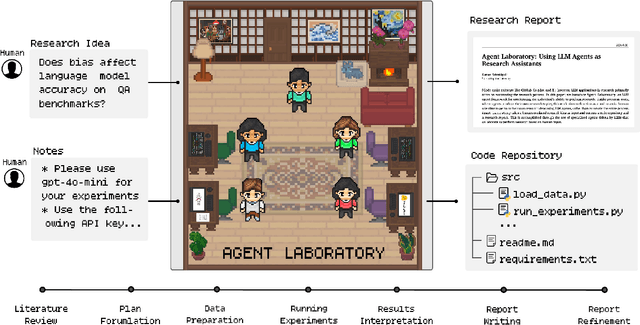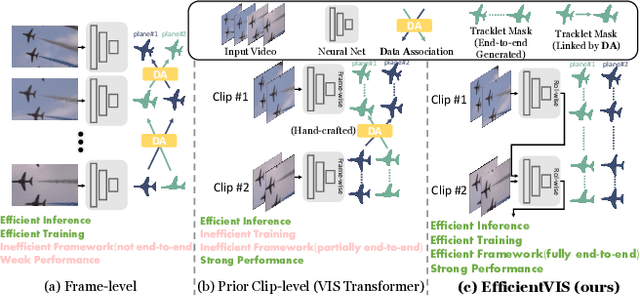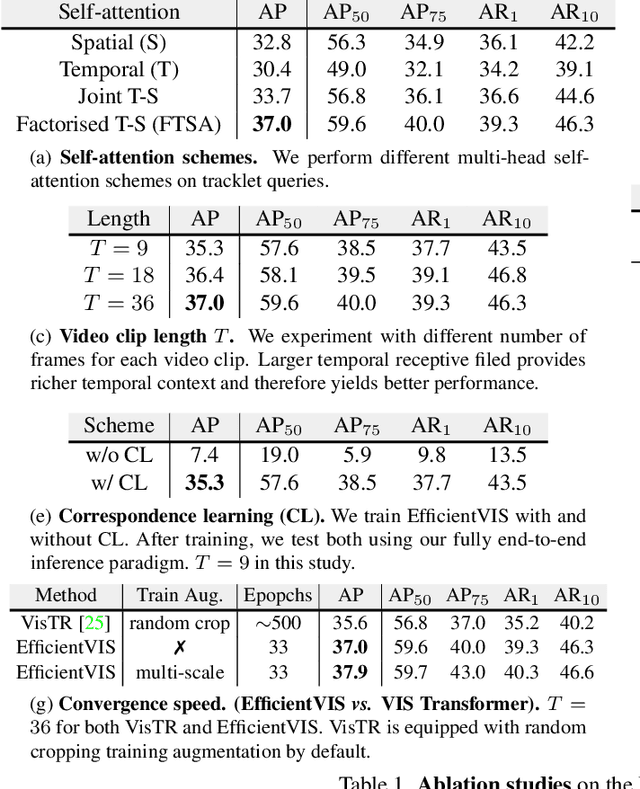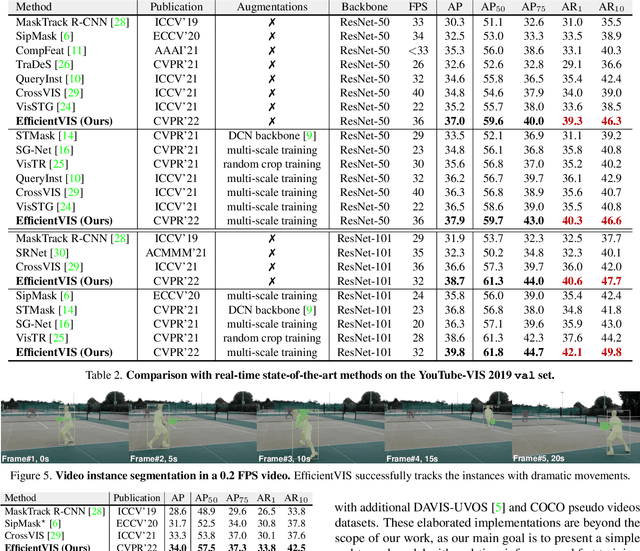Jialian Wu
Instella-T2I: Pushing the Limits of 1D Discrete Latent Space Image Generation
Jun 26, 2025Abstract:Image tokenization plays a critical role in reducing the computational demands of modeling high-resolution images, significantly improving the efficiency of image and multimodal understanding and generation. Recent advances in 1D latent spaces have reduced the number of tokens required by eliminating the need for a 2D grid structure. In this paper, we further advance compact discrete image representation by introducing 1D binary image latents. By representing each image as a sequence of binary vectors, rather than using traditional one-hot codebook tokens, our approach preserves high-resolution details while maintaining the compactness of 1D latents. To the best of our knowledge, our text-to-image models are the first to achieve competitive performance in both diffusion and auto-regressive generation using just 128 discrete tokens for images up to 1024x1024, demonstrating up to a 32-fold reduction in token numbers compared to standard VQ-VAEs. The proposed 1D binary latent space, coupled with simple model architectures, achieves marked improvements in speed training and inference speed. Our text-to-image models allow for a global batch size of 4096 on a single GPU node with 8 AMD MI300X GPUs, and the training can be completed within 200 GPU days. Our models achieve competitive performance compared to modern image generation models without any in-house private training data or post-training refinements, offering a scalable and efficient alternative to conventional tokenization methods.
TTT-Bench: A Benchmark for Evaluating Reasoning Ability with Simple and Novel Tic-Tac-Toe-style Games
Jun 11, 2025Abstract:Large reasoning models (LRMs) have demonstrated impressive reasoning capabilities across a broad range of tasks including Olympiad-level mathematical problems, indicating evidence of their complex reasoning abilities. While many reasoning benchmarks focus on the STEM domain, the ability of LRMs to reason correctly in broader task domains remains underexplored. In this work, we introduce \textbf{TTT-Bench}, a new benchmark that is designed to evaluate basic strategic, spatial, and logical reasoning abilities in LRMs through a suite of four two-player Tic-Tac-Toe-style games that humans can effortlessly solve from a young age. We propose a simple yet scalable programmatic approach for generating verifiable two-player game problems for TTT-Bench. Although these games are trivial for humans, they require reasoning about the intentions of the opponent, as well as the game board's spatial configurations, to ensure a win. We evaluate a diverse set of state-of-the-art LRMs, and \textbf{discover that the models that excel at hard math problems frequently fail at these simple reasoning games}. Further testing reveals that our evaluated reasoning models score on average $\downarrow$ 41\% \& $\downarrow$ 5\% lower on TTT-Bench compared to MATH 500 \& AIME 2024 respectively, with larger models achieving higher performance using shorter reasoning traces, where most of the models struggle on long-term strategic reasoning situations on simple and new TTT-Bench tasks.
Unleashing Hour-Scale Video Training for Long Video-Language Understanding
Jun 05, 2025Abstract:Recent long-form video-language understanding benchmarks have driven progress in video large multimodal models (Video-LMMs). However, the scarcity of well-annotated long videos has left the training of hour-long Video-LLMs underexplored. To close this gap, we present VideoMarathon, a large-scale hour-long video instruction-following dataset. This dataset includes around 9,700 hours of long videos sourced from diverse domains, ranging from 3 to 60 minutes per video. Specifically, it contains 3.3M high-quality QA pairs, spanning six fundamental topics: temporality, spatiality, object, action, scene, and event. Compared to existing video instruction datasets, VideoMarathon significantly extends training video durations up to 1 hour, and supports 22 diverse tasks requiring both short- and long-term video comprehension. Building on VideoMarathon, we propose Hour-LLaVA, a powerful and efficient Video-LMM for hour-scale video-language modeling. It enables hour-long video training and inference at 1-FPS sampling by leveraging a memory augmentation module, which adaptively integrates user question-relevant and spatiotemporal-informative semantics from a cached full video context. In our experiments, Hour-LLaVA achieves the best performance on multiple long video-language benchmarks, demonstrating the high quality of the VideoMarathon dataset and the superiority of the Hour-LLaVA model.
MOVi: Training-free Text-conditioned Multi-Object Video Generation
May 29, 2025Abstract:Recent advances in diffusion-based text-to-video (T2V) models have demonstrated remarkable progress, but these models still face challenges in generating videos with multiple objects. Most models struggle with accurately capturing complex object interactions, often treating some objects as static background elements and limiting their movement. In addition, they often fail to generate multiple distinct objects as specified in the prompt, resulting in incorrect generations or mixed features across objects. In this paper, we present a novel training-free approach for multi-object video generation that leverages the open world knowledge of diffusion models and large language models (LLMs). We use an LLM as the ``director'' of object trajectories, and apply the trajectories through noise re-initialization to achieve precise control of realistic movements. We further refine the generation process by manipulating the attention mechanism to better capture object-specific features and motion patterns, and prevent cross-object feature interference. Extensive experiments validate the effectiveness of our training free approach in significantly enhancing the multi-object generation capabilities of existing video diffusion models, resulting in 42% absolute improvement in motion dynamics and object generation accuracy, while also maintaining high fidelity and motion smoothness.
KeyVID: Keyframe-Aware Video Diffusion for Audio-Synchronized Visual Animation
Apr 13, 2025Abstract:Generating video from various conditions, such as text, image, and audio, enables both spatial and temporal control, leading to high-quality generation results. Videos with dramatic motions often require a higher frame rate to ensure smooth motion. Currently, most audio-to-visual animation models use uniformly sampled frames from video clips. However, these uniformly sampled frames fail to capture significant key moments in dramatic motions at low frame rates and require significantly more memory when increasing the number of frames directly. In this paper, we propose KeyVID, a keyframe-aware audio-to-visual animation framework that significantly improves the generation quality for key moments in audio signals while maintaining computation efficiency. Given an image and an audio input, we first localize keyframe time steps from the audio. Then, we use a keyframe generator to generate the corresponding visual keyframes. Finally, we generate all intermediate frames using the motion interpolator. Through extensive experiments, we demonstrate that KeyVID significantly improves audio-video synchronization and video quality across multiple datasets, particularly for highly dynamic motions. The code is released in https://github.com/XingruiWang/KeyVID.
Self-Taught Agentic Long Context Understanding
Feb 21, 2025Abstract:Answering complex, long-context questions remains a major challenge for large language models (LLMs) as it requires effective question clarifications and context retrieval. We propose Agentic Long-Context Understanding (AgenticLU), a framework designed to enhance an LLM's understanding of such queries by integrating targeted self-clarification with contextual grounding within an agentic workflow. At the core of AgenticLU is Chain-of-Clarifications (CoC), where models refine their understanding through self-generated clarification questions and corresponding contextual groundings. By scaling inference as a tree search where each node represents a CoC step, we achieve 97.8% answer recall on NarrativeQA with a search depth of up to three and a branching factor of eight. To amortize the high cost of this search process to training, we leverage the preference pairs for each step obtained by the CoC workflow and perform two-stage model finetuning: (1) supervised finetuning to learn effective decomposition strategies, and (2) direct preference optimization to enhance reasoning quality. This enables AgenticLU models to generate clarifications and retrieve relevant context effectively and efficiently in a single inference pass. Extensive experiments across seven long-context tasks demonstrate that AgenticLU significantly outperforms state-of-the-art prompting methods and specialized long-context LLMs, achieving robust multi-hop reasoning while sustaining consistent performance as context length grows.
Agent Laboratory: Using LLM Agents as Research Assistants
Jan 08, 2025



Abstract:Historically, scientific discovery has been a lengthy and costly process, demanding substantial time and resources from initial conception to final results. To accelerate scientific discovery, reduce research costs, and improve research quality, we introduce Agent Laboratory, an autonomous LLM-based framework capable of completing the entire research process. This framework accepts a human-provided research idea and progresses through three stages--literature review, experimentation, and report writing to produce comprehensive research outputs, including a code repository and a research report, while enabling users to provide feedback and guidance at each stage. We deploy Agent Laboratory with various state-of-the-art LLMs and invite multiple researchers to assess its quality by participating in a survey, providing human feedback to guide the research process, and then evaluate the final paper. We found that: (1) Agent Laboratory driven by o1-preview generates the best research outcomes; (2) The generated machine learning code is able to achieve state-of-the-art performance compared to existing methods; (3) Human involvement, providing feedback at each stage, significantly improves the overall quality of research; (4) Agent Laboratory significantly reduces research expenses, achieving an 84% decrease compared to previous autonomous research methods. We hope Agent Laboratory enables researchers to allocate more effort toward creative ideation rather than low-level coding and writing, ultimately accelerating scientific discovery.
GRiT: A Generative Region-to-text Transformer for Object Understanding
Dec 01, 2022Abstract:This paper presents a Generative RegIon-to-Text transformer, GRiT, for object understanding. The spirit of GRiT is to formulate object understanding as <region, text> pairs, where region locates objects and text describes objects. For example, the text in object detection denotes class names while that in dense captioning refers to descriptive sentences. Specifically, GRiT consists of a visual encoder to extract image features, a foreground object extractor to localize objects, and a text decoder to generate open-set object descriptions. With the same model architecture, GRiT can understand objects via not only simple nouns, but also rich descriptive sentences including object attributes or actions. Experimentally, we apply GRiT to object detection and dense captioning tasks. GRiT achieves 60.4 AP on COCO 2017 test-dev for object detection and 15.5 mAP on Visual Genome for dense captioning. Code is available at https://github.com/JialianW/GRiT
Deformable VisTR: Spatio temporal deformable attention for video instance segmentation
Mar 12, 2022



Abstract:Video instance segmentation (VIS) task requires classifying, segmenting, and tracking object instances over all frames in a video clip. Recently, VisTR has been proposed as end-to-end transformer-based VIS framework, while demonstrating state-of-the-art performance. However, VisTR is slow to converge during training, requiring around 1000 GPU hours due to the high computational cost of its transformer attention module. To improve the training efficiency, we propose Deformable VisTR, leveraging spatio-temporal deformable attention module that only attends to a small fixed set of key spatio-temporal sampling points around a reference point. This enables Deformable VisTR to achieve linear computation in the size of spatio-temporal feature maps. Moreover, it can achieve on par performance as the original VisTR with 10$\times$ less GPU training hours. We validate the effectiveness of our method on the Youtube-VIS benchmark. Code is available at https://github.com/skrya/DefVIS.
Efficient Video Instance Segmentation via Tracklet Query and Proposal
Mar 03, 2022



Abstract:Video Instance Segmentation (VIS) aims to simultaneously classify, segment, and track multiple object instances in videos. Recent clip-level VIS takes a short video clip as input each time showing stronger performance than frame-level VIS (tracking-by-segmentation), as more temporal context from multiple frames is utilized. Yet, most clip-level methods are neither end-to-end learnable nor real-time. These limitations are addressed by the recent VIS transformer (VisTR) which performs VIS end-to-end within a clip. However, VisTR suffers from long training time due to its frame-wise dense attention. In addition, VisTR is not fully end-to-end learnable in multiple video clips as it requires a hand-crafted data association to link instance tracklets between successive clips. This paper proposes EfficientVIS, a fully end-to-end framework with efficient training and inference. At the core are tracklet query and tracklet proposal that associate and segment regions-of-interest (RoIs) across space and time by an iterative query-video interaction. We further propose a correspondence learning that makes tracklets linking between clips end-to-end learnable. Compared to VisTR, EfficientVIS requires 15x fewer training epochs while achieving state-of-the-art accuracy on the YouTube-VIS benchmark. Meanwhile, our method enables whole video instance segmentation in a single end-to-end pass without data association at all.
 Add to Chrome
Add to Chrome Add to Firefox
Add to Firefox Add to Edge
Add to Edge